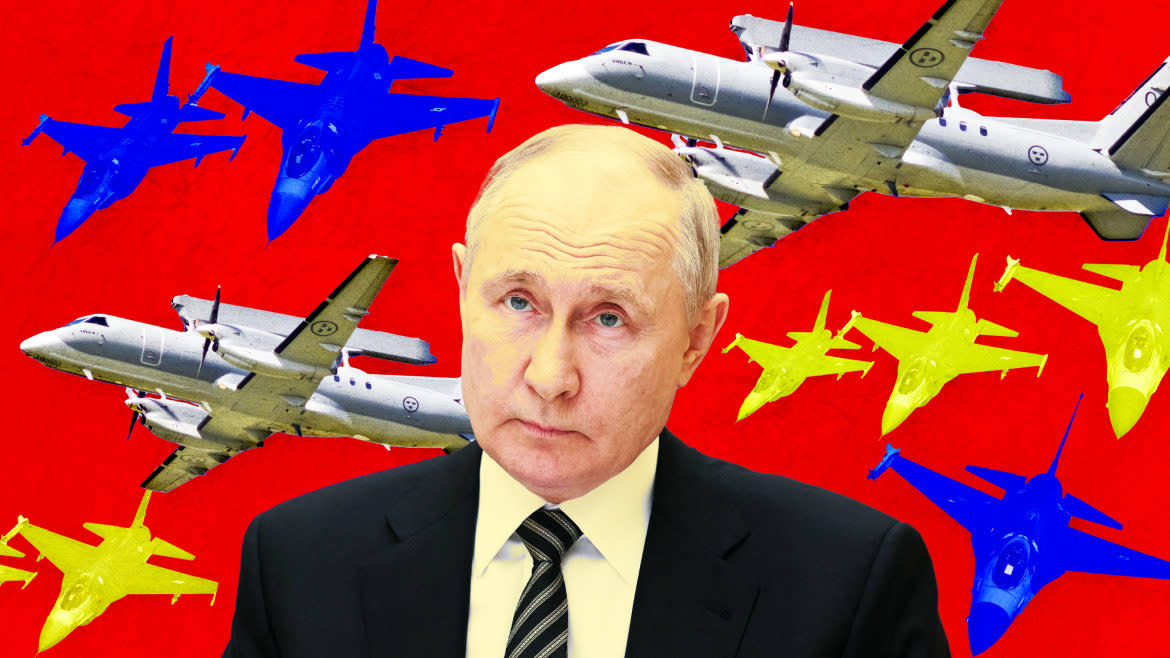One-Two Punch From the Skies Is a Massive Blow to Putin

Ukraine’s military has spent the last two years chronically short of planes. Its prewar stocks were already small in number and mostly dated from the Soviet era. When NATO and other countries sent help, they focused on either sending the same older models or keeping existing aircraft in the air through maintenance and spare parts. Russia, meanwhile, has a larger and often more advanced air force.
However, new planes are on the way to help Ukraine. For nearly a year, countries like the Netherlands have promised limited numbers of U.S.-made F-16 fighter jets. Recently, Belgium also committed to sending 30 F-16s from its own stocks.
These aircraft can come in handy in a few ways. Firstly, they can engage Russia’s air force, balancing out its numerical advantage. Ukraine’s dynamic and improving air defense efforts have already made things challenging for the Russian air force, but they still maintain a large advantage. Their airpower lets them launch munitions at Ukraine’s forces and cities and force Ukrainian pilots to be extremely careful with their own operations. Degrading Russia’s air force relieves some pressure on Ukraine’s beleaguered ground forces, which are struggling to hold back intense Russian offensives supported by Russian bombing. F-16s can also help ground forces directly by dropping their own munitions and firing long-range missiles. Having F-16s opens the door for more and better Western weapons, which were designed to work on an F-16 but could not be adapted to Ukraine’s Soviet-era airframes. Ukraine will also get more out of Western systems already sent. Some partners have helped jerry-rig upgrades so that Ukraine’s air force could use weapons not designed for Soviet planes. In videos over the past year, Ukrainian pilots showed tablets in their cockpit which operated Western-provided missiles. While they already function in a limited capacity, these systems will be more effective when used in F-16s as intended.
Donating F-16s touches on a major ongoing debate among Ukraine’s partners: whether to allow Ukraine to use their weapons against Russian territory. Some U.S. policymakers worry that letting Ukraine use their weapons in areas other than occupied Ukrainian territory will trigger escalation with Moscow. The Biden administration has nonetheless OKed strikes in limited circumstances. Others, notably in Britain, do not consider this escalatory and argue that Russia can take advantage of restrictions by keeping parts of its military in Russia, where Ukraine has less ability to hit them. Ukraine does have some long-range weapons of its own, such as its one-way attack drones, but these are limited in stock and less effective against well-defended targets than the traditional missile or artillery systems provided by Western partners.
In the debate over how Ukraine can use donated weapons, Belgian officials told the press that Ukraine ought to only use donated aircraft “for utilization by the Ukraine Defense Forces on Ukraine[’s] territory.” The restrictions prompt a few questions. Since many Russian aircraft launch bombs and missiles from Russian territory, could a Ukrainian jet enter Russian airspace to intercept them? Could a Ukrainian jet stay in Ukrainian territory but fire a missile provided by another country at a target in Russia? These questions are key to the effectiveness of the donated aircraft and how Ukraine will try to use them once they’re operational.
Aircraft other than F-16s are also on the way. On May 29, Sweden promised to send two ASC 890 surveillance aircraft, which add an extra dimension to Ukraine’s future airpower. The ASC 890 is an airborne early warning and control (AEW&C) aircraft with a powerful radar that can track potential air and ground threats far beyond Ukraine’s ground-based radars and the F-16’s own suite of sensors. It can also send that information directly to Ukraine’s new jets. While the F-16 is a formidable aircraft, it benefits from broader awareness of what’s in the area. Sweden had previously indicated it was willing to send its own Gripen aircraft, but paused their plans so that Ukraine could focus on servicing and maintaining F-16s instead of trying to incorporate two new kinds of aircraft at once.
In all, donations mean that Ukraine will likely end up with two AEW&C aircraft and several dozen F-16s, though some will likely be held in reserve for contingencies, training, or spare parts. The big question is when any of these aircraft will arrive in Ukraine. Currently, Ukrainian pilots are in the midst of training with donated F-16s in Romania, but the actual delivery of aircraft to Ukraine will be anyone’s guess. Belgium, one of the largest donors, has only committed to sending some of the pledged jets by the end of the year. The U.S., despite being the manufacturer and one of the largest operators of F-16s, has not pledged any at all, though they are training Ukrainian pilots and giving the green light for countries to send them to Ukraine.
Jets are not a guarantee of Ukrainian victory, but they are essential to Ukraine’s defense. Like tanks, aircraft are just a part of a larger complex system. However, gaining more freedom in the air is a vital step for Ukraine to stabilize its front lines with Russia, and potentially regain some of the territory it’s lost to Vladimir Putin’s forces.
Get the Daily Beast's biggest scoops and scandals delivered right to your inbox. Sign up now.
Stay informed and gain unlimited access to the Daily Beast's unmatched reporting. Subscribe now.


